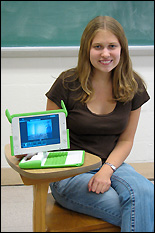Educating the World's Kids One Laptop at a Time
What did you do on your last summer vacation? Department of Chemical and Biomolecular Engineering sophomore Mary Yanik spent hers on a project that combined technology, education and social change with a trip to the other side of the world: she was part of a One Laptop Per Child (OLPC) project team in Ambatoharanana, Madagascar.
A double major in both engineering and Government and Politics, as well as a member of the Gemstone program and Engineers Without Borders (EWB), Yanik's personal interests include integrating science and society, and examining science's social effects. "OLPC is a great example of that," she says. "They're a nonprofit that has enormous social implications for the world. Their goals are to further education and empower children. They do that through technology, so you need the science behind it in order to really affect those children's lives."
OLPC is dedicated to providing the world's poorest children with tough, low-cost laptops capable of connecting to the Internet and pre-loaded with software and features designed to promote creativity and collaborative learning. The organization designed its own laptop, the XO, to be cost-effective, kid-friendly, and able to withstand third-world environments.
As a freshman, Yanik was a member of an EWB team scheduled to work on a project in Peru, but when complications resulted in the trip being canceled, she stepped up her efforts to participate in the OLPC program. Her experience in EWB, she says, was "an inspiration", and her activities with the group and access to its resources prepared her to take on a similar challenge, but with a far less established support system.
Unlike EWB, OLPC doesn't have a formal presence on campus. "The program we did over the summer was the first of its kind [for OLPC]," Yanik explains. "They've never really involved college students or interns before. Usually, the programs are government funded and they send out a lot more laptops at once." OLPC accepted applications from teams of three to four students, asking them to propose a project site, school, or nonprofit that would benefit from having the laptops, and how they would be deployed and used. Thirty student teams, including Yanik's, were selected. Teams were issued a laptop for each member, 100 laptops for the project, and $10,000.
Yanik and her teammates—students Michael Buckwald, Kate Doyle, and Sean Robinson from George Washington University—proposed working with a Canadian nonprofit organization called The Madagascar School Project (MSP) after connecting with MSP committee member Joseline Beaulieu on OLPC's website. MSP runs a well-established primary school in Ambatoharanana called Lova Soa. Their goal in working with OLPC is to integrate computers with the classroom, giving teachers and students new educational opportunities and an alternative to traditional rote learning. Neither the teachers nor the students had worked with computers before, but everyone, including the children's parents, was enthusiastic about the project.
Once they received the laptops, the children, aged between five and seven years old, eagerly began to play and explore. One of their first projects was to build something out of the XOs' packing materials, and then document what they had created using the computers. In other projects they worked with the laptops' built-in camera and microphone, created music and art, read e-books, played games, and even tried out some simple programming. They also got a taste of social networking and file sharing—even in the absence of an Internet connection, the XOs can wirelessly connect with each other. Teachers learned about maintaining and troubleshooting the computers, and set up course management software for future use.
The OLPC team hopes to return to Madagascar, this time to install solar panels that can be used to charge the laptops, so the school will no longer have to rely on what Yanik describes as a "precarious" connection to Madagascar's power grid. At present the team is writing a best-practices report, fundraising for the Lova Soa school, and advocating for the expansion of the OLPC project with MSP and throughout the country.
The OLPC/MSP project benefited Yanik almost as much as the students and teachers. "The most important thing I learned was how much the kids could learn to do by themselves, and how much they taught each other," she says. "They were teaching us in some sense. It changed my expectations of education."
For More Information:
The UMD/GWU OLPC Blog »
Related Story:
Mary Yanik and her OLPC teammates attended OLPC's "Fighting Insurgencies with Laptops" event, held in Washington, D.C. in September. Keynote speaker Senator John McCain (R-Arizona) explained why he feels OLPC can be used to combat violence with education and hope. Learn More and See Pictures from the Event »
November 9, 2009 Prev Next |
|



 "The teachers didn't see it as a criticism of their teaching style," Yanik explains, "but [thought], 'Well, now that we have the laptops, we can teach in a different way. We can do more.' Since it provides feedback, the laptop also facilitates children learning on their own, outside the classroom. Part of [MSP's] methodology is to let the kids discover solutions rather than give them explicit instructions on what to do with the device."
"The teachers didn't see it as a criticism of their teaching style," Yanik explains, "but [thought], 'Well, now that we have the laptops, we can teach in a different way. We can do more.' Since it provides feedback, the laptop also facilitates children learning on their own, outside the classroom. Part of [MSP's] methodology is to let the kids discover solutions rather than give them explicit instructions on what to do with the device."